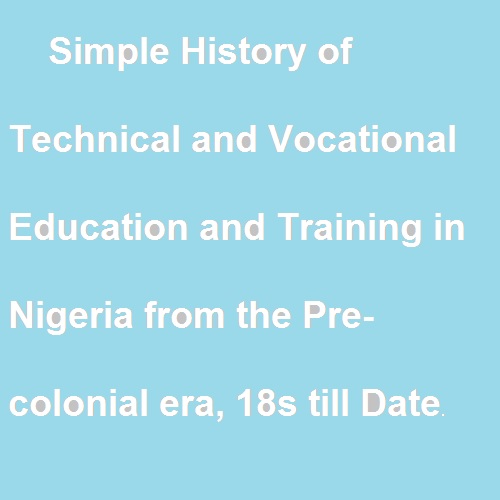History of Technical and Vocational Education and Training in Nigeria from the 70s till Date.
The history of technical and vocational education and training is discussed in this article from the precolonial period to till Date.
Pre-colonial era
The history of technical and vocational education and training in Nigeria can be traced to the pre-colonial era when vocational education occurred in the traditional system where parents, family members, and associates provide opportunities for their children, friends, and colleagues to learn some self-reliance and self-sustaining skills in the informal system
through basket and mat weaving, sculpturing, blacksmithing, carving, plantation and arable crop farming, fishing, animal rearing, hair making, dressmaking, bead making, leatherwork, pottery, brick making, and learning of trade in these products.
Colonial Era
The severe missionary activity in Southern Nigeria facilitated the enactment of the education ordinance in Nigeria in 1887 and the establishment of the Hope Waddell Training Institute in (1895) marking it the first technical institution in Nigeria to train technical and vocational specialists such as tailors, carpenters, traders, teachers of trades and specialized crafts.
The slow start of technical and vocational education institutions in Nigeria necessitated an agreement between British and African governments in 1925 for the governments to fund and establish more technical education for the acquisition of skills, resulting in the establishment of the Yaba High College in January 1934 to provide technical and vocational education and training in subjects like agriculture, forestry, veterinary medicines, survey, civil engineering, auto mechanical engineering, and the training of science teachers for the teaching Technical and vocational education and training in Nigeria.
Similarly, the University College, Ibadan, was established in 1948 to provide Technical and vocational education and training programs in art and vocational outfits in the informal setting to produce mechanics, electricians, and auto-body repair to service the vehicles of the missionaries, and many technical and vocational education and training colleges were recommended for expansion in 1952 and 1953 across the country to provide relevant vocational and technical skills for individuals.
Read Also: Top3 Components of Technical and Vocation Education and Training (TVET)” You Are Not Aware of
Post-Colonial Era
In 1960, the Ashby Commission Report led to the opening of the first generational Universities in Nigeria, which are the University of Nigeria, Nsukka, in the East, Lagos in the West, Ahmadu Bello University, Maiduguri, in the North, University of Benin in the South, University of Ife, West, university of Jos in the North, University of Nigeria, port Harcourt has faculty of education, technical and vocational education and training for acquisition of appropriate skill to relevant in the world of work and for national development.
The Nigerian Technical and vocational education institution has passed through many stages of reformation and transformation from the 6:5:3:5 system of education to the 6:3:3:4 and the 9:3:4 system of education.
The 1981 National Policy on Education places more emphasis on technical education and vocational training with the following objectives: That TVET is an integral part of general education, that TVET is lifelong learning and preparation for responsible citizens, that TVET is an instrument for promoting environmental sound and sustainable development, that TVET can help decrease the rate of poverty, and that TVET is a means for preparing for the occupational field and effective participation in the world of work.
The 6:3:3:4 educational system consists of (6 years) of primary school for students to acquire skills in home science, agriculture, fine art (local craft), and introductory technology, (3 Years ) in junior primary school where acquired skills in home economics, business study, agriculture, fine art ( local craft) basic technology, and sciences, (3 Years) in senior secondary school where student are made to acquire science and vocational subjects, and (4 years) in post-secondary school.
In (2005) the 6:3:3:4 education system was structured into the 9:3:4 education system. (9 years) is structured as a lower basic education curriculum ( primaries 1-3), middle basic education curriculum (primaries 4-6), and upper basic (JSS 1-3), (3 Years) in senior secondary school where students can acquire science and vocational subjects skills, and (4years) post-secondary school (i.e., collect of education, polytechnics, Universities) where an advance course in science and technical and vocational education are taught.
In 1976, the National Board For Technical Education was established to set minimum requirements for the nature of skills to be offered in technical colleges and the mandate to award certificates.
Today, there are about 170 universities in Nigeria, 43 federal universities, and 79 private Universities,
as well as federal, and state polytechnics, colleges of education, and agriculture offering courses in technical and vocational education and training in Nigeria, awarding certificates in technologies and vocations.
In conclusion
The discussion of technical and vocational education and training in Nigeria will not be complete without a vivid look at the history of technical and vocational education and training in Nigeria.
In this article, we have carefully traced the history of TVET from the Pre-colonial era to the colonial era, and to date.
